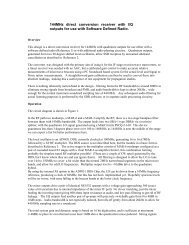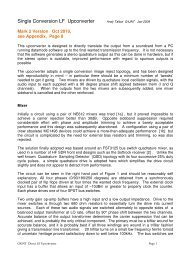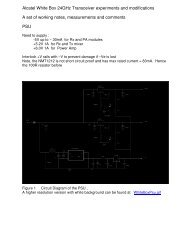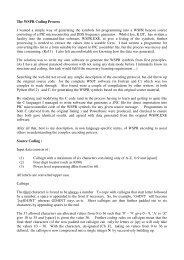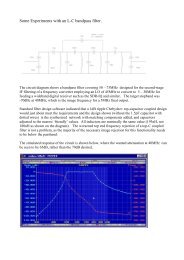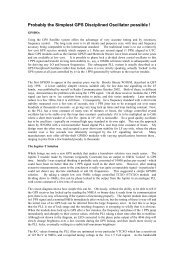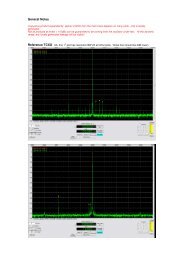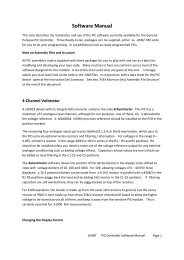JT4 Data on the UKµWG Reverse DDS Module - G4JNT
JT4 Data on the UKµWG Reverse DDS Module - G4JNT
JT4 Data on the UKµWG Reverse DDS Module - G4JNT
You also want an ePaper? Increase the reach of your titles
YUMPU automatically turns print PDFs into web optimized ePapers that Google loves.
<str<strong>on</strong>g>JT4</str<strong>on</strong>g> <str<strong>on</strong>g>Data</str<strong>on</strong>g> <strong>on</strong> <strong>the</strong> <strong>UKµWG</strong> <strong>Reverse</strong> <strong>DDS</strong> <strong>Module</strong>Andy Talbot <strong>G4JNT</strong> April 2010<str<strong>on</strong>g>JT4</str<strong>on</strong>g> OverviewThe <str<strong>on</strong>g>JT4</str<strong>on</strong>g>G data mode, part of <strong>the</strong> WSJT Suite by Joe Taylor, K1JT, [1] has proved its capabilityfor getting through under extremely weak signal c<strong>on</strong>diti<strong>on</strong>s, and can cope with fading, frequencydrift and up to several hundred Hz of frequency scattering. Its weak signal performance al<strong>on</strong>eappears to show about 6dB advantage over aural copied CW. A <str<strong>on</strong>g>JT4</str<strong>on</strong>g>G message has been addedto three of <strong>the</strong> Bell Hill beac<strong>on</strong>s, GB3SCS, GB3SCC, and GB3SCX <strong>on</strong> 2.3, 5.76 and 10GHz, andis also in use <strong>on</strong> <strong>the</strong> Central Scotland 10GHz beac<strong>on</strong> GB3CSB.<str<strong>on</strong>g>JT4</str<strong>on</strong>g> in all its variants (A-G) c<strong>on</strong>sists of a four t<strong>on</strong>e Multi Frequency Shift Keyed (4-MFSK)waveform, with <strong>the</strong> spacing between <strong>the</strong> t<strong>on</strong>es chosen depending <strong>on</strong> <strong>the</strong> frequency band andexpected spreading. On microwaves <strong>the</strong> widest spacing, <strong>the</strong> G variant, has been adopted.C<strong>on</strong>versely, at HF <strong>the</strong> narrowest is used with 4.375Hz t<strong>on</strong>e spacing The MFSK messagec<strong>on</strong>sists of 207 symbols (<strong>on</strong>e of four sequential t<strong>on</strong>es) transmitted at a rate of 4.375Hz, <strong>the</strong> wholemessage <strong>the</strong>refore taking about 48 sec<strong>on</strong>ds to send. A rigid timing structure is in use, and <strong>the</strong>start of <strong>the</strong> transmissi<strong>on</strong> must coincide with <strong>the</strong> UTC minute interval. For beac<strong>on</strong> usage, <strong>the</strong> evenminute has been universally chosen as <strong>the</strong> reference start time. For <strong>the</strong> decoder to workcorrectly, this start point must be accurately defined, being no more than a few sec<strong>on</strong>ds late, andno more than <strong>on</strong>e sec<strong>on</strong>d early (<strong>the</strong> protocol was originally designed for EME with its 2 sec<strong>on</strong>dsdelay). For beac<strong>on</strong> use <strong>the</strong> entire message c<strong>on</strong>tains exactly 13 characters taken from analphabet of letters, numbers and a few punctuati<strong>on</strong> symbols.The <strong>UKµWG</strong> R<strong>DDS</strong> board can be used to generate <str<strong>on</strong>g>JT4</str<strong>on</strong>g> data by replacing <strong>the</strong> PIC with <strong>on</strong>ec<strong>on</strong>taining <strong>the</strong> appropriate firmware, and additi<strong>on</strong> of a GPS receiver supplying timing informati<strong>on</strong>.The PIC decodes <strong>the</strong> serial data from <strong>the</strong> GPS receive <strong>the</strong>n at <strong>the</strong> even-minute point reads prestoredmessage data and c<strong>on</strong>verts this to <str<strong>on</strong>g>JT4</str<strong>on</strong>g> modulati<strong>on</strong> by reprogramming <strong>the</strong> <strong>DDS</strong> in real-timeat 4.375Hz with values corresp<strong>on</strong>ding to each of <strong>the</strong> four t<strong>on</strong>e frequencies. The four frequencieshave to be calculated beforehand and are stored in <strong>the</strong> PICs n<strong>on</strong>-volatile memory, al<strong>on</strong>g with <strong>the</strong>message symbol data and certain o<strong>the</strong>r setup parameters.A CW message is stored and is replayed immediately <strong>the</strong> <str<strong>on</strong>g>JT4</str<strong>on</strong>g> transmissi<strong>on</strong> has completed,starting at approximately <strong>the</strong> even minute + 50 sec<strong>on</strong>ds mark. At a user definable point, insec<strong>on</strong>ds after <strong>the</strong> odd minute, <strong>the</strong> CW message is again replayed. In typical usage this allowsCW idents spaced by around 30 sec<strong>on</strong>ds with periods of plain carrier of at least <strong>the</strong> recommended20 sec<strong>on</strong>ds. Adjusting <strong>the</strong> time of <strong>the</strong> sec<strong>on</strong>d CW message allows <strong>on</strong>e extended period ofcarrier every two minutes.C<strong>on</strong>necting <strong>the</strong> GPS module.The 20 pin expansi<strong>on</strong> header provided within <strong>the</strong> R<strong>DDS</strong> unit is used for interfacing to <strong>the</strong> GPS.Three data lines are used, although <strong>on</strong>ly two are actually <strong>on</strong>ly needed for <str<strong>on</strong>g>JT4</str<strong>on</strong>g> operati<strong>on</strong>. Thethird allows GPS receiver setup informati<strong>on</strong> to be sent at start up of <strong>the</strong> c<strong>on</strong>troller if needed. Inextreme cases, if reduced accuracy of <strong>the</strong> timing is acceptable <strong>on</strong>ly <strong>the</strong> serial data is essential.<str<strong>on</strong>g>JT4</str<strong>on</strong>g> for R<strong>DDS</strong> <strong>Module</strong> <strong>G4JNT</strong> Page 1
The 7805 regulator in <strong>the</strong> R<strong>DDS</strong> module has sufficient spare capability to supply <strong>the</strong> 100 – 200mAneeded by most GPS receiver modules that take a +5V input, although users may have to beaware of any additi<strong>on</strong>al heat sinking requirements that may be necessary.The descripti<strong>on</strong> that follows, as well as <strong>the</strong> PIC firmware supplied, assumes that serial data in <strong>on</strong>eof two formats is available. The proprietary binary format given by <strong>the</strong> Motorola Oncore or M12type GPS module at 9600 baud or standard NMEA text messages at 4800 baud. The polarity of<strong>the</strong> data can be selected at <strong>the</strong> time <strong>the</strong> PIC firmware is compiled. Ei<strong>the</strong>r native 5V logic orRS232 polarity can be catered-forAt <strong>the</strong> time of writing, suitable Oncore GPS receiver modules are available from [2] Note thatthis family of modules can be commanded to supply data in NMEA format, but given <strong>the</strong> choice,<strong>the</strong> binary versi<strong>on</strong> is preferable.Figure 1 shows <strong>the</strong> interface c<strong>on</strong>necti<strong>on</strong>s, specifically for <strong>the</strong> Oncore <strong>Module</strong> with its 10 pinheader, and includes an additi<strong>on</strong>al red/green LED for fr<strong>on</strong>t panel mounting.<str<strong>on</strong>g>JT4</str<strong>on</strong>g> for R<strong>DDS</strong> <strong>Module</strong> <strong>G4JNT</strong> Page 2
Table 1 below lists <strong>the</strong> generalised c<strong>on</strong>necti<strong>on</strong> details for <strong>the</strong> R<strong>DDS</strong> interface for c<strong>on</strong>necti<strong>on</strong>s too<strong>the</strong>r GPS receiver modules.R<strong>DDS</strong> Header Functi<strong>on</strong> PIC I/F2 +5V supply to GPS <strong>Module</strong>4 & 8 Ground7 Test Link to ground–carrier, leave O/C normally PB59 Serial <str<strong>on</strong>g>Data</str<strong>on</strong>g> Out TO GPS (opti<strong>on</strong>al) PB411 Serial <str<strong>on</strong>g>Data</str<strong>on</strong>g> In FROM GPS PB317 One Pulse Per Sec<strong>on</strong>d signal FROM GPS PB0The existing Green and Red LEDs mounted <strong>on</strong> <strong>the</strong> PCB are retained and <strong>the</strong> descripti<strong>on</strong> thatfollows assumes LED1 is green, and LED2 <strong>the</strong> red <strong>on</strong>e. These are <strong>on</strong> PIC I/O lines PB1 and PB2respectively. Users may care to bring <strong>the</strong> c<strong>on</strong>necti<strong>on</strong>s to <strong>the</strong>se (pins 13 and 15) out to anexternal anti-parallel c<strong>on</strong>nected red/green LED (with additi<strong>on</strong>al series resistor) for fr<strong>on</strong>t panelmounting as it gives useful informati<strong>on</strong> about message progress and GPS lock c<strong>on</strong>diti<strong>on</strong>.PIC Coding DetailsAll informati<strong>on</strong> relating to <strong>the</strong> message, frequencies and setup need to be programmed into <strong>the</strong>PIC at <strong>the</strong> start. There is no facility for field updating with an RS232 interface as was provided <strong>on</strong><strong>the</strong> original R<strong>DDS</strong> implementati<strong>on</strong> and all values need to be included within <strong>the</strong> source file whichis compiled to give <strong>the</strong> .HEX file for download to <strong>the</strong> PIC device. Several compile-time flagsneed to be specified to customise <strong>the</strong> compiled code. These relate to <strong>the</strong> data polarity, <strong>the</strong> dataformat and whe<strong>the</strong>r <strong>the</strong> 1 PPS signal is used. Also whe<strong>the</strong>r, for straight <strong>DDS</strong> use, <strong>the</strong> internal PLLclock multiplier is to be enabled. This PLL must NOT be enabled for reverse <strong>DDS</strong> use as <strong>the</strong>rewill be a danger of over clocking (and cooking) <strong>the</strong> <strong>DDS</strong> chip.The basic PIC firmware is c<strong>on</strong>tained in <strong>the</strong> source file <str<strong>on</strong>g>JT4</str<strong>on</strong>g>BCN_9851.ASM which is usedunmodified. The <str<strong>on</strong>g>JT4</str<strong>on</strong>g> symbol informati<strong>on</strong> resides in an auxiliary include file <str<strong>on</strong>g>JT4</str<strong>on</strong>g>SYMBS.INCwhich can be generated automatically by <strong>the</strong> utility GEN<str<strong>on</strong>g>JT4</str<strong>on</strong>g>.EXE. Alternatively, <strong>the</strong> symbols canbe derived from <strong>the</strong> WSJT software, following Joe’s instructi<strong>on</strong>s supplied with <strong>the</strong> software suite,formatted and entered manually into <strong>the</strong> include file. Each of <strong>the</strong> 207 symbols is formed fromtwo bits giving a value from 0 – 3 which are packed four to a byte, most significant first to give 51bytes in total. (As listed, <strong>the</strong>y are read out in order left to right, top to bottom)User informati<strong>on</strong> such as frequencies and <strong>the</strong> compiler flags described above is stored in ano<strong>the</strong>rinclude file <str<strong>on</strong>g>JT4</str<strong>on</strong>g>_9851.INC whose c<strong>on</strong>tents are shown in <strong>the</strong> example below. Please note,formatting is important, so read <strong>the</strong> descripti<strong>on</strong> below thoroughly before modifying <strong>the</strong> .INC files.<str<strong>on</strong>g>JT4</str<strong>on</strong>g> for R<strong>DDS</strong> <strong>Module</strong> <strong>G4JNT</strong> Page 3
<str<strong>on</strong>g>JT4</str<strong>on</strong>g>_9851.INC;Compile-time FlagsNMEAPol = 1 ;Polarity of data from GPS 5V Logic = 0 RS232 = 1GPS<str<strong>on</strong>g>Data</str<strong>on</strong>g>Type = 1 ;0 for Motorola Oncore 9600 baud, 1 = NMEA 4800 baudIgnorePPS = 1 ;0 for normal PPS. 1 for use data <strong>on</strong>ly (less accurate);Compiler C<strong>on</strong>stantsCWSPEED = d'75' ;CW Dot length, msREFTONE = 0 ;Reference T<strong>on</strong>e No. for defining tuning etc.KEYUPTONE = 4;T<strong>on</strong>es 0 - 3 are <strong>the</strong> <str<strong>on</strong>g>JT4</str<strong>on</strong>g> <strong>on</strong>es. Set <strong>the</strong>KEYDWNTONE = 0 ; reference and FSK t<strong>on</strong>es in <strong>the</strong> range 0 - 7CWMSG2 = d'30' ;Sec<strong>on</strong>ds count for CW message during odd minute; EE <str<strong>on</strong>g>Data</str<strong>on</strong>g>Freq<str<strong>on</strong>g>Data</str<strong>on</strong>g> ;Labels must start in Column 1;10368.905 MHz for R<strong>DDS</strong>, *96 multiplierde 0x17, 0xB3, 0x9E, 0x57 ;<str<strong>on</strong>g>JT4</str<strong>on</strong>g> T<strong>on</strong>e 0de 0x17, 0xB3, 0x9E, 0x4B ;<str<strong>on</strong>g>JT4</str<strong>on</strong>g> T<strong>on</strong>e 1de 0x17, 0xB3, 0x9E, 0x3F ;<str<strong>on</strong>g>JT4</str<strong>on</strong>g> T<strong>on</strong>e 2de 0x17, 0xB3, 0x9E, 0x33 ;<str<strong>on</strong>g>JT4</str<strong>on</strong>g> T<strong>on</strong>e 3de 0x17, 0xB3, 0x9E, 0x45;User defined T<strong>on</strong>e 4 1270Hzde 0x17, 0xB3, 0x9E, 0x57 ; T<strong>on</strong>e 5 800Hzde 0x17, 0xB3, 0x9E, 0x57 ; T<strong>on</strong>e 6 800Hzde 0x17, 0xB3, 0x9E, 0x4F ; T<strong>on</strong>e 7 1000HzCWMsg de "<strong>G4JNT</strong> IO90IV58",0 ;Null TerminatedC<strong>on</strong>trolPLL de 0 ;0 for no PLL, 1 for x6 PLL (NOT for R<strong>DDS</strong> use!)Values shown as d’45’ are normal decimal values, ideally used for simple variables. Numbers in<strong>the</strong> format 0x34 are hexadecimal, generally produced from <strong>the</strong> utilities for deriving frequencyand <str<strong>on</strong>g>JT4</str<strong>on</strong>g> symbol data.Any text following a semi-col<strong>on</strong> ; is a comment and ignored by <strong>the</strong> PIC compiler.<str<strong>on</strong>g>JT4</str<strong>on</strong>g> for R<strong>DDS</strong> <strong>Module</strong> <strong>G4JNT</strong> Page 4
Labels such as Freq<str<strong>on</strong>g>Data</str<strong>on</strong>g>, CWMsg and C<strong>on</strong>trolPLL must start <strong>on</strong> <strong>the</strong> left hand side, in column 1.All o<strong>the</strong>r lines should be indented o<strong>the</strong>rwise <strong>the</strong> compiler will throw-up a warning messageCompile-time flags.NMEAPol defines if <strong>the</strong> polarity of <strong>the</strong> data coming from <strong>the</strong> GPS receiver is 0/5V logic level assupplied directly by most GPS modules, or RS232 polarity for direct c<strong>on</strong>necti<strong>on</strong> to a PC. Someearly Garmin modules supply this latter polarity, as do some GPS receiver systems. . Use 0 for5V Logic level / polarity, 1 for RS232.Please note that if true positive/negative RS232 voltage levels are encountered, an additi<strong>on</strong>alresistor of around 4k7 needs to be inserted in <strong>the</strong> <str<strong>on</strong>g>Data</str<strong>on</strong>g> In line to prevent excessive current into <strong>the</strong>PIC interface pinGPS<str<strong>on</strong>g>Data</str<strong>on</strong>g>Type should be set to 0 for Motorola binary format data at 9600 baud; Use 1 forNMEA ASCII format at 4800 baudIgnorePPS should be set to 0 if <strong>the</strong> 1 PPS signal is used to define <strong>the</strong> exact edge of <strong>the</strong> UTCsec<strong>on</strong>d. A value of 1 should be used if <strong>the</strong> timing is derived from <strong>the</strong> serial data <strong>on</strong>ly withoutc<strong>on</strong>necti<strong>on</strong> of a 1 PPS signal. This situati<strong>on</strong> may be preferred if timing data is derived from a GPSsimulator such as an MSF time code utility, where <strong>the</strong> provisi<strong>on</strong> of a 1 PPS timing pulse will likelyoffer no greater accuracy than that of <strong>the</strong> serial data al<strong>on</strong>e.Compiler C<strong>on</strong>stantsCWSPEED is a compiler c<strong>on</strong>stant and defines <strong>the</strong> dot length of <strong>the</strong> CW, in millisec<strong>on</strong>ds. Used’100’ for 12WPM, d’75’ for 16WPM etc.REFTONE is <strong>the</strong> t<strong>on</strong>e number (see below) in <strong>the</strong> range 0 – 7 defining which of <strong>the</strong> pre-storedfrequencies is to be used for <strong>the</strong> period of plain carrier. This is usually <strong>the</strong> designated referencefrequency for <strong>the</strong> beac<strong>on</strong>KEYUPTONE is a number in <strong>the</strong> range 0 – 7 defining which of <strong>the</strong> pre-stored frequencies isused for FSK keying t<strong>on</strong>e in <strong>the</strong> KEY-UP stateKEYDWNTONE in <strong>the</strong> range 0 – 7 defines <strong>the</strong> FSK keying t<strong>on</strong>e for <strong>the</strong> KEY-DOWN state.Current advised UK beac<strong>on</strong> practice for simple two frequency keying is to use <strong>the</strong> nominatedfrequency for key-down and for plain carrier, and <strong>the</strong> shifted <strong>on</strong>e (usually 400Hz higher infrequency) for <strong>the</strong> key up state. In this case, REFTONE and KEYDWNTONE will be equal, withKEYUPTONE <strong>the</strong> alternative. The eighth t<strong>on</strong>e is spare.CWMSG2 is <strong>the</strong> number of sec<strong>on</strong>ds after <strong>the</strong> odd minute that <strong>the</strong> sec<strong>on</strong>d CW message is sent.Adjust its value to ensure a sufficient period of plain carrier is available for m<strong>on</strong>itoring purposes.EE <str<strong>on</strong>g>Data</str<strong>on</strong>g><str<strong>on</strong>g>JT4</str<strong>on</strong>g> for R<strong>DDS</strong> <strong>Module</strong> <strong>G4JNT</strong> Page 5
Freq<str<strong>on</strong>g>Data</str<strong>on</strong>g> is a label signifying <strong>the</strong> start of <strong>the</strong> frequency data, and MUST occur at <strong>the</strong> extreme leftof <strong>the</strong> .INC file.The next 8 lines (starting de to signify <strong>the</strong>y are EEPROM data) each c<strong>on</strong>tain <strong>the</strong> 32 bits (4bytes) of frequency informati<strong>on</strong> for <strong>the</strong> eight pre-stored frequencies, corresp<strong>on</strong>ding to t<strong>on</strong>es 0 – 7,most significant byte first. Although shown in Hex, it is permissible to list <strong>the</strong>se in decimal notati<strong>on</strong>if this is preferred for calculati<strong>on</strong> purposes. The first four lines are <strong>the</strong> frequencies of each of <strong>the</strong><str<strong>on</strong>g>JT4</str<strong>on</strong>g> symbols. The next four are t<strong>on</strong>es that can be selected by <strong>the</strong> user to give, for example, areference at exactly <strong>the</strong> mid point in <strong>the</strong> spectrum (t<strong>on</strong>e 1.5) or a pair of precisely spaced t<strong>on</strong>es forCW keying. Which t<strong>on</strong>e is allocated to which functi<strong>on</strong> is defined in <strong>the</strong> secti<strong>on</strong> above, and it is noteven necessary to calculate any values for frequencies 4 – 7 if all keying uses <strong>the</strong> <str<strong>on</strong>g>JT4</str<strong>on</strong>g> t<strong>on</strong>es. Inthis case programme a value of zero into <strong>the</strong> unused spaces. The programming frequencygenerati<strong>on</strong> utility <str<strong>on</strong>g>JT4</str<strong>on</strong>g>_<strong>DDS</strong>_Freqs.EXE gives <strong>the</strong> opti<strong>on</strong> of copy-and-pasting directly into <strong>the</strong>.INClude file. Highlight <strong>the</strong> generated frequency data <strong>the</strong>n copy and paste directly underneath<strong>the</strong> Freq<str<strong>on</strong>g>Data</str<strong>on</strong>g> label, deleting old data and adding comments as appropriate.CWMsg is a label to show that this line is EEPROM data c<strong>on</strong>taining <strong>the</strong> CW message insideinverted commas. It can be of arbitrary length and <strong>the</strong>re is space for about 40 characters. Thedata must have a zero, a null terminator, after <strong>the</strong> closing inverted commas exactly as shown toindicate <strong>the</strong> end of <strong>the</strong> message. If not present, <strong>the</strong> software will crash! If <strong>the</strong> CW message is tool<strong>on</strong>g <strong>the</strong> compiler will generate an error message about data being overwritten.The final line, C<strong>on</strong>trolPLL is a flag to indicate whe<strong>the</strong>r <strong>the</strong> <strong>DDS</strong> clock X6 multiplier is to be used.For R<strong>DDS</strong> c<strong>on</strong>figurati<strong>on</strong> it must be set to 0 - PLL disabled. When this PIC code used with astandal<strong>on</strong>e source, <strong>the</strong> PLL may be enabled.<str<strong>on</strong>g>JT4</str<strong>on</strong>g>SYMBS.INCThis include file is generated automatically in exactly <strong>the</strong> form shown as a result of running <strong>the</strong>utility GEN<str<strong>on</strong>g>JT4</str<strong>on</strong>g>.EXE. [3] It should not be necessary to alter <strong>the</strong> file in any way. As <strong>the</strong> file isregenerated and overwritten each time GEN<str<strong>on</strong>g>JT4</str<strong>on</strong>g> is run, it is advisable to save a copy under adifferent name – eg, GB3SCS_<str<strong>on</strong>g>JT4</str<strong>on</strong>g>SYMBS.INC.The WSJT software does offer <strong>the</strong> ability to generate <strong>the</strong> symbol data in a listed form, and usersmay want to use this route instead – for example to include a ‘QSO-type’ message into <strong>the</strong>beac<strong>on</strong> data instead of 13 characters of plain text. In this case, <strong>the</strong> individual symbol data in <strong>the</strong>form of 207 numbers with values 0 – 3 will have to be assembled manually into <strong>the</strong> EE databytes, four-at-a-time starting with <strong>the</strong> most significant pair of bits. For example, if <strong>the</strong> first eightsymbols generated are 3,1,2,0,2,1,3,0, <strong>the</strong> resulting first two bytes will be b’11011000’ andb’10011100’ or in hex 0xD8, 0xC0. Both <strong>the</strong>se formats, binary or hex, (or even decimal as d’nn’) are acceptable to <strong>the</strong> compiler. Read <strong>the</strong> WSJT documentati<strong>on</strong> for fur<strong>the</strong>r details of how togenerate <strong>the</strong> symbol list.<str<strong>on</strong>g>JT4</str<strong>on</strong>g> for R<strong>DDS</strong> <strong>Module</strong> <strong>G4JNT</strong> Page 6
; <str<strong>on</strong>g>JT4</str<strong>on</strong>g> Symbols generated from GEN<str<strong>on</strong>g>JT4</str<strong>on</strong>g> <strong>G4JNT</strong> Jul 2009; Message data 'GB3SCS IO80UU'de 0x00, 0xD8, 0x14, 0xDA, 0xC4, 0x02, 0x8D, 0x28de 0xAA, 0x0A, 0xC7, 0x9C, 0xEF, 0xD6, 0x68, 0xC3de 0xA5, 0x74, 0x2C, 0x6A, 0x75, 0x1E, 0xB8, 0x34de 0xC4, 0xC6, 0xF5, 0xC4, 0x67, 0x33, 0x9D, 0xA4de 0x59, 0x76, 0xA9, 0x65, 0x83, 0x53, 0x73, 0x50de 0xC0, 0x51, 0xE9, 0x2B, 0x57, 0x63, 0xE2, 0x34de 0x26, 0x73, 0xD6, 0x6C<str<strong>on</strong>g>JT4</str<strong>on</strong>g> Software Operati<strong>on</strong>When power is first applied <strong>the</strong> <strong>DDS</strong> will be initialised to <strong>the</strong> reference frequency and <strong>the</strong> CWmessage will be sent <strong>on</strong>ce, with <strong>the</strong> red led flashing in sympathy with <strong>the</strong> CW characters. Thegreen led will flash <strong>on</strong>ce and <strong>the</strong> GPS data line is m<strong>on</strong>itored for a valid ‘GPS Valid’ code arriving .In <strong>the</strong> NMEA $GPRMC string this is <strong>the</strong> “A” sent in <strong>the</strong> third data item, in Motorola protocol itappears as a flag in <strong>the</strong> appropriate positi<strong>on</strong>. Until <strong>the</strong> GPS is c<strong>on</strong>firmed as valid, <strong>the</strong> CWmessage will be sent repeatedly with a single flash of <strong>the</strong> green LED between messages.As so<strong>on</strong> as <strong>the</strong> GPS receiver indicates valid data is now present <strong>the</strong> green LED will start to give ashort flash <strong>on</strong>ce per sec<strong>on</strong>d in synchr<strong>on</strong>ism with <strong>the</strong> serial data stream which is c<strong>on</strong>tinuouslym<strong>on</strong>itored to determine <strong>the</strong> GPS lock status. Note that when NMEA data is used – <strong>the</strong> flash isvery short. With <strong>the</strong> GPS-locked flag is detected, <strong>the</strong> pattern is l<strong>on</strong>g flash every sec<strong>on</strong>d (forNMEA it will appear to be almost c<strong>on</strong>tinuously <strong>on</strong>). If <strong>the</strong> GPS receiver subsequently loses lock,<strong>the</strong> PIC m<strong>on</strong>itors <strong>the</strong> GPSValid flag and changes to a short green flash to show this. Since mostGPS receivers will still be outputting valid data and retain <strong>the</strong>ir timing during such flywheeloperati<strong>on</strong>, no fur<strong>the</strong>r acti<strong>on</strong> is taken by this software o<strong>the</strong>r than <strong>the</strong> short green flash to indicateloss of lock. When lock is reacquired, l<strong>on</strong>g green flashes resume.The time sent from <strong>the</strong> receiver is decoded and as so<strong>on</strong> as <strong>the</strong> first sec<strong>on</strong>d of <strong>the</strong> even minute isdetected, <strong>the</strong> <str<strong>on</strong>g>JT4</str<strong>on</strong>g> transmissi<strong>on</strong> starts <strong>on</strong> <strong>the</strong> next PPS edge. While <str<strong>on</strong>g>JT4</str<strong>on</strong>g> data is being sent, <strong>the</strong> redLED flashes at half symbol rate, about 0.45 sec<strong>on</strong>d intervals. When <strong>the</strong> <str<strong>on</strong>g>JT4</str<strong>on</strong>g> message iscomplete, <strong>the</strong> frequency is shifted first to <strong>the</strong> reference t<strong>on</strong>e for <strong>on</strong>e sec<strong>on</strong>d, <strong>the</strong>n <strong>the</strong> FSK CWmessage is sent, with <strong>the</strong> red LED flashing in time with <strong>the</strong> key-down state of <strong>the</strong> CW. And <strong>the</strong>end of this, <strong>the</strong> green flashes resume while plain carrier at <strong>the</strong> reference frequency is beinggenerated. When <strong>the</strong> programmed sec<strong>on</strong>d CW time is reached, <strong>the</strong> red LED again flashes toshow <strong>the</strong> CW characters, followed by green <strong>on</strong>e sec<strong>on</strong>d flashes until <strong>the</strong> even minute when <strong>the</strong>cycle repeats If <strong>the</strong> green flashing becomes of short durati<strong>on</strong>, this means <strong>the</strong> GPS receiver haslost lock, possibly due to interference or jamming. The timing will usually flywheel for manyhours or even days before <strong>the</strong> resulting cumulative timing error becomes unacceptable.Test ModeThe link or switch installed <strong>on</strong> pin 7 of <strong>the</strong> interface header provides c<strong>on</strong>tinuous carrier at <strong>the</strong>reference t<strong>on</strong>e frequency (REFTONE) for test purposes. If activated during <strong>the</strong> CW or <str<strong>on</strong>g>JT4</str<strong>on</strong>g>sequence, this is allowed to complete before Test Mode is entered. The red LED is <strong>on</strong>c<strong>on</strong>tinuously.References<str<strong>on</strong>g>JT4</str<strong>on</strong>g> for R<strong>DDS</strong> <strong>Module</strong> <strong>G4JNT</strong> Page 7
[1] http://physics.princet<strong>on</strong>.edu/pulsar/K1JT/[2] http://www.alan.melia.btinternet.co.uk/[3] http://www.g4jnt.com/JTModesBcns.htm<str<strong>on</strong>g>JT4</str<strong>on</strong>g> for R<strong>DDS</strong> <strong>Module</strong> <strong>G4JNT</strong> Page 8



